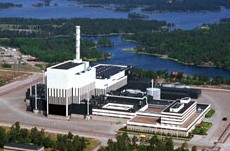Swedish nuclear power plant operators will incorporate improvements highlighted by stress tests with a pre-existing program to standardise safety in earthquake scenarios.
 |
| Oskarshamn 3 (Image: OKG) |
On a common schedule, many of the countries have in recent days confirmed that their nuclear power plants are properly sited, designed and managed. However, a statement from the Swedish Radiation Safety Authority (SSM) frankly pointed out that: "What we can already see is that some plants do not fully meet requirements in the case of earthquakes. Here we will need to take action."
Jan Hanberg, SSM's head of radiation protection who led the stress test program, explained to World Nuclear News that there were no specific earthquake requirements in the early days of the Swedish nuclear program. The country relied on the intrinsic strength of each design in scenarios of strong earthquakes, which are highly unlikely due to Sweden's geology. Of the country's ten reactors, only Oskarshamn 3 and Forsmark 3 were licensed to specific earthquake resistance standards.
This potential gap in safety was addressed during 2005 by new earthquake-specific regulation imposed in a way that gave operators until 2013 to ensure their existing plants met requirements. Stress tests, however, had to be conducted based on the plant status as of 1 July this year. Hanberg told WNN that nuclear plant operators will continue to work towards the 2013 deadline, but may introduce additional safety measures in light of what has been learned through the stress tests. That may require a revision of the 2013 deadline, he said, depending on the programs of work agreed by SSM and the operators over the next month.
Some work will also be needed to ensure safety in scenarios involving a site with multiple reactors challenged simultaneously. SSM wants to be certain there will be sufficient command, control and fire-fighting capability.
Separately, SSM noted that Swedish nuclear power plants have excellent protection against radioactive release during accident scenarios. As part of learning from the 1979 accident at Three Mile Island in the USA all Swedish nuclear power plants were required to have filters to reduce the amount of radioactive material that would be released in an accident.
Researched and written
by World Nuclear News




_18570.jpg)
_18938.jpg)
_33584.jpg)
_82983.jpg)





